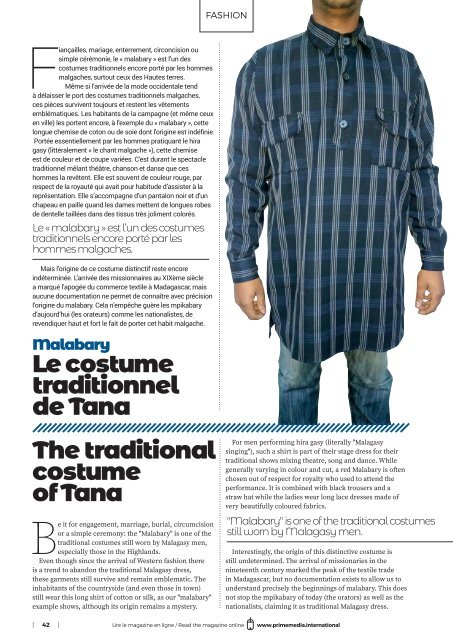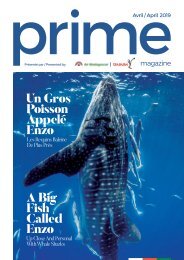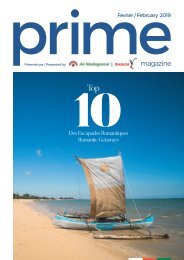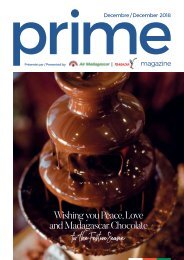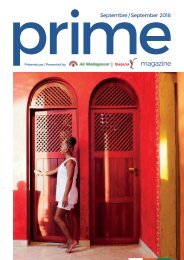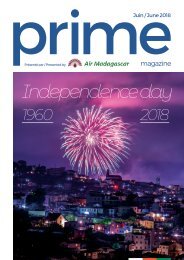PRIME MAG - AIR MAD - AUGUST 2018 - SINGLE PAGES - WEB - LO-RES
Create successful ePaper yourself
Turn your PDF publications into a flip-book with our unique Google optimized e-Paper software.
FASHION<br />
Fiançailles, mariage, enterrement, circoncision ou<br />
simple cérémonie, le « malabary » est l’un des<br />
costumes traditionnels encore porté par les hommes<br />
malgaches, surtout ceux des Hautes terres.<br />
Même si l’arrivée de la mode occidentale tend<br />
à délaisser le port des costumes traditionnels malgaches,<br />
ces pièces survivent toujours et restent les vêtements<br />
emblématiques. Les habitants de la campagne (et même ceux<br />
en ville) les portent encore, à l’exemple du « malabary », cette<br />
longue chemise de coton ou de soie dont l’origine est indéfinie.<br />
Portée essentiellement par les hommes pratiquant le hira<br />
gasy (littéralement « le chant malgache »), cette chemise<br />
est de couleur et de coupe variées. C’est durant le spectacle<br />
traditionnel mêlant théâtre, chanson et danse que ces<br />
hommes la revêtent. Elle est souvent de couleur rouge, par<br />
respect de la royauté qui avait pour habitude d’assister à la<br />
représentation. Elle s’accompagne d’un pantalon noir et d’un<br />
chapeau en paille quand les dames mettent de longues robes<br />
de dentelle taillées dans des tissus très joliment colorés.<br />
Le « malabary » est l’un des costumes<br />
traditionnels encore porté par les<br />
hommes malgaches.<br />
Mais l’origine de ce costume distinctif reste encore<br />
indéterminée. L’arrivée des missionnaires au XIXème siècle<br />
a marqué l’apogée du commerce textile à Madagascar, mais<br />
aucune documentation ne permet de connaître avec précision<br />
l’origine du malabary. Cela n’empêche guère les mpikabary<br />
d’aujourd’hui (les orateurs) comme les nationalistes, de<br />
revendiquer haut et fort le fait de porter cet habit malgache.<br />
Malabary<br />
Le costume<br />
traditionnel<br />
de Tana<br />
The traditional<br />
costume<br />
of Tana<br />
Be it for engagement, marriage, burial, circumcision<br />
or a simple ceremony: the "Malabary" is one of the<br />
traditional costumes still worn by Malagasy men,<br />
especially those in the Highlands.<br />
Even though since the arrival of Western fashion there<br />
is a trend to abandon the traditional Malagasy dress,<br />
these garments still survive and remain emblematic. The<br />
inhabitants of the countryside (and even those in town)<br />
still wear this long shirt of cotton or silk, as our "malabary"<br />
example shows, although its origin remains a mystery.<br />
For men performing hira gasy (literally "Malagasy<br />
singing"), such a shirt is part of their stage dress for their<br />
traditional shows mixing theatre, song and dance. While<br />
generally varying in colour and cut, a red Malabary is often<br />
chosen out of respect for royalty who used to attend the<br />
performance. It is combined with black trousers and a<br />
straw hat while the ladies wear long lace dresses made of<br />
very beautifully coloured fabrics.<br />
"Malabary" is one of the traditional costumes<br />
still worn by Malagasy men.<br />
Interestingly, the origin of this distinctive costume is<br />
still undetermined. The arrival of missionaries in the<br />
nineteenth century marked the peak of the textile trade<br />
in Madagascar, but no documentation exists to allow us to<br />
understand precisely the beginnings of malabary. This does<br />
not stop the mpikabary of today (the orators) as well as the<br />
nationalists, claiming it as traditional Malagasy dress.<br />
| 42 | Lire le magazine en ligne / Read the magazine online www.primemedia.international


